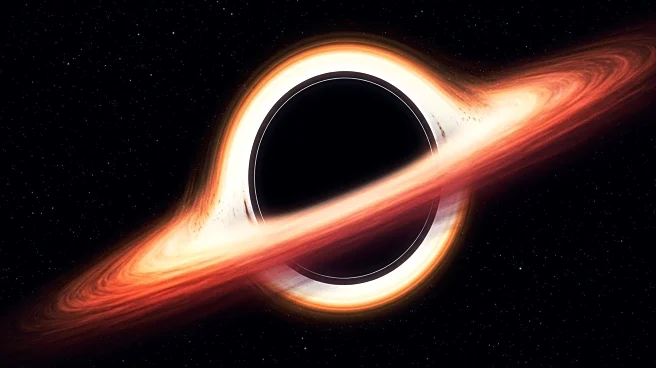What is the story about?
What's Happening?
Astronomers have identified what may be the largest black hole ever discovered, with a mass 36 billion times that of the Sun. Located in the Cosmic Horseshoe galaxy, this ultramassive black hole bends the light of a background galaxy into an Einstein ring. The discovery, detailed in the Monthly Notices of the Royal Astronomical Society, highlights the black hole's immense gravitational pull, which is strong enough to warp light into a near-perfect circle. This finding provides insight into the end state of galaxy and black hole formation, as the Cosmic Horseshoe is a fossil group formed from the collapse of large galaxies.
Why It's Important?
The discovery of this ultramassive black hole is crucial for understanding the mechanisms behind the formation of supermassive black holes. It challenges existing theories about how such massive objects can form and grow, especially given their presence early in the universe's history. The study suggests that galactic mergers may play a significant role in the development of these colossal entities. This finding could lead to new models of galaxy evolution and black hole growth, impacting cosmological research and our understanding of the universe's structure.
What's Next?
Researchers plan to use the gravitational lensing effect and stellar kinematics to further study the black hole's mass and its impact on surrounding stars. This method allows astronomers to detect and measure the mass of dormant black holes across the universe, even when they are not actively accreting matter. The study may prompt further investigations into the relationship between galaxy size and black hole mass, potentially leading to new discoveries about the universe's most massive objects.
Beyond the Headlines
The discovery raises questions about the limits of black hole growth and the processes that lead to their formation. It challenges scientists to explore the conditions that allow such massive black holes to exist, potentially leading to breakthroughs in cosmology. The study also highlights the importance of gravitational lensing as a tool for observing distant cosmic phenomena, offering a glimpse into the universe's most extreme environments.
AI Generated Content
Do you find this article useful?














